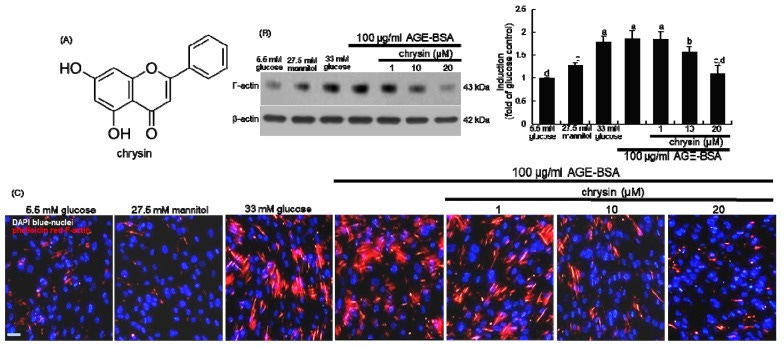Friday Hope: Chrysin (Propolis) Inhibits Actin Remodeling and Protein Misfolding
Another Potential Powerful Therapeutic Against SARS-CoV-2 and its Spike Protein
FIGURE 1. Chemical structure of chrysin (A), and inhibition of F-actin induction by chrysin in advanced glycation end products (AGE)-bovine serum albumin (BSA)-exposed human renal mesangial cells (HRMC, B and C). HRMC were challenged with 5.5 mM glucose, 5.5 mM glucose plus 27.5 mM mannitol as osmotic controls or with 33 mM glucose or 100 μg/mL AGE-BSA in the absence and presence of 1–20 μM chrysin. The F-actin induction was measured by Western blot analysis using cell lysates with a primary antibody of F-actin (B). β-Actin protein was used as an internal control. Representative blots shown are typical of three independent experiments. The bar graphs (mean ± SEM) in the right panel represent quantitative results obtained from a densitometer. Values not sharing a letter are different at p < 0.05. Red-rhodamine phalloidin staining for F-actin formation was conducted in AGE-BSA-exposed HRMC (C). Nuclear counter-staining was done by using blue 4’,6-diamidino-2-phenylindole. Scale bar = 50 µm. Each photograph is representative of at least four animals. Magnification: 200-fold.
As readers if my Substack know, I am taking the finding that the Spike Protein induces Actin Remodeling of red blood cells seriously. I am almost certain that this mechanism is ubiquitous as the Integrin Receptors on platelets are found on all nucleated cells.
Chrysin, a flavonoid compound found in bee pollen and propolis, has the ability to modulate the Actin Remodeling induced by the Spike Protein.
Nevertheless, these findings shed light on a therapeutic role for chrysin in modulating aberrant actin remodeling and abnormal coordination between F-actin and focal adhesion in mesangial cells during glucose or AGE-induced glomerular injury.
Dietary Chrysin Suppresses Formation of Actin Cytoskeleton and Focal Adhesion in AGE-Exposed Mesangial Cells and Diabetic Kidney: Role of Autophagy
https://www.ncbi.nlm.nih.gov/pmc/articles/PMC6705957/
Furthermore, Chrysin has the additional property of being able to inhibit ER stress-mediated misfolding. This (please see previous posts) is another mechanism of the Spike Protein. I believe the evidence shows that once the Spike Protein has invaded the Endothelium, it then proceeds to invade tissues and organs, resulting in mistranslation (misfolding) of essential proteins.
To reveal that chrysin inhibited ER stress-mediated misfolding of slit diaphragm proteins, this study examined the induction of podocin and nephrin in high glucose-exposed podocytes and in diabetic glomerular tissues. Our findings highlight the mechanism by which chrysin combats ER stress to provide a possible new therapeutic target for podocyte loss and glomerular filtration barrier injury.
FIGURE 2. Chemical structure (A) and cytotoxicity (B) of chrysin and inhibitory effects of chrysin on viability (C) and DNA fragmentation (D) in high glucose-exposed podocytes. Podocytes were incubated in media containing different glucose contents (5.5 mmol/L glucose and 27.5 mmol/L mannitol as osmotic controls and 33 mmol/L glucose in the absence or presence of 1–20 μmol/L chrysin for 3 d). Podocyte viability (mean±SEM, n=5) was measured using the MTT assay and expressed as percent cell survival relative to that of the glucose controls. The DNA fragmentation in podocytes was measured using the TUNEL assay, and nuclear staining was accomplished with DAPI (D). Representative microphotographs were obtained by fluorescence microscopy with a fluorescein green filter. Magnification: ×200. Fluorescence intensity was quantified by using an Axiomager microscope system. *P<0.05 vs 5.5 mmol/L glucose or 27.5 mmol/L mannitol. #P<0.05 vs 33 mmol/L glucose alone.
Chrysin ameliorates podocyte injury and slit diaphragm protein loss via inhibition of the PERK-eIF2α-ATF-CHOP pathway in diabetic mice
https://www.ncbi.nlm.nih.gov/pmc/articles/PMC5547556/
Therefore, we should immediately begin trials with Propolis (Chrysin) to determine its efficacy in both preventing and treating Spike Protein (SARS-CoV-2) related pathologies.





HONEY 🍯 MORE HONEY 🍯
Thanks again, Walter. I really do look forward to these every Friday...almost as much as the teasers of your gourmet dinners and smoke!